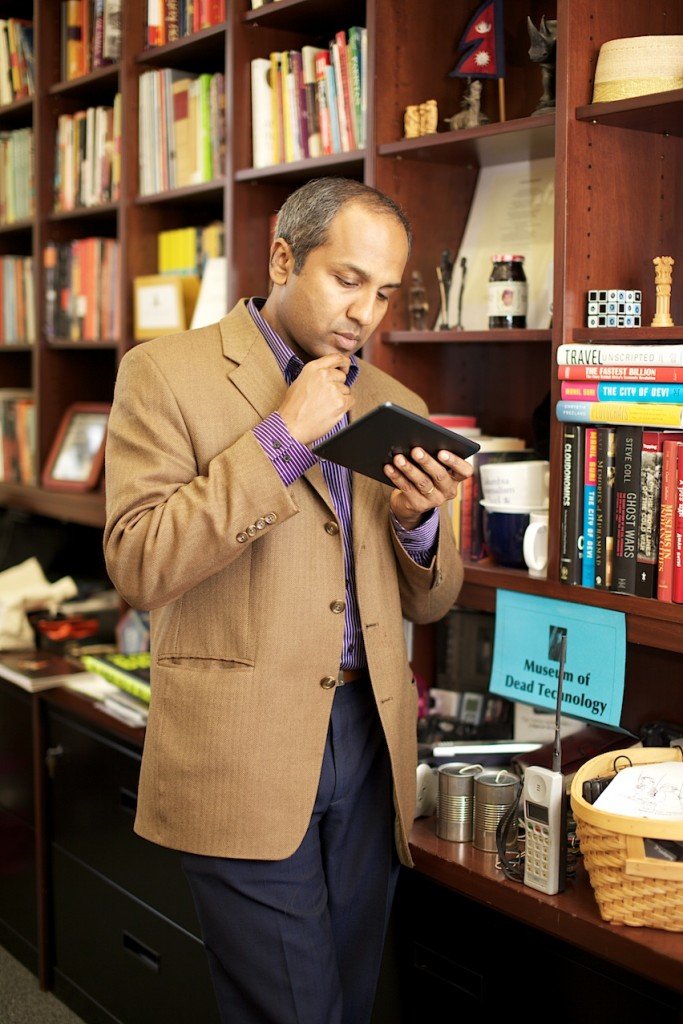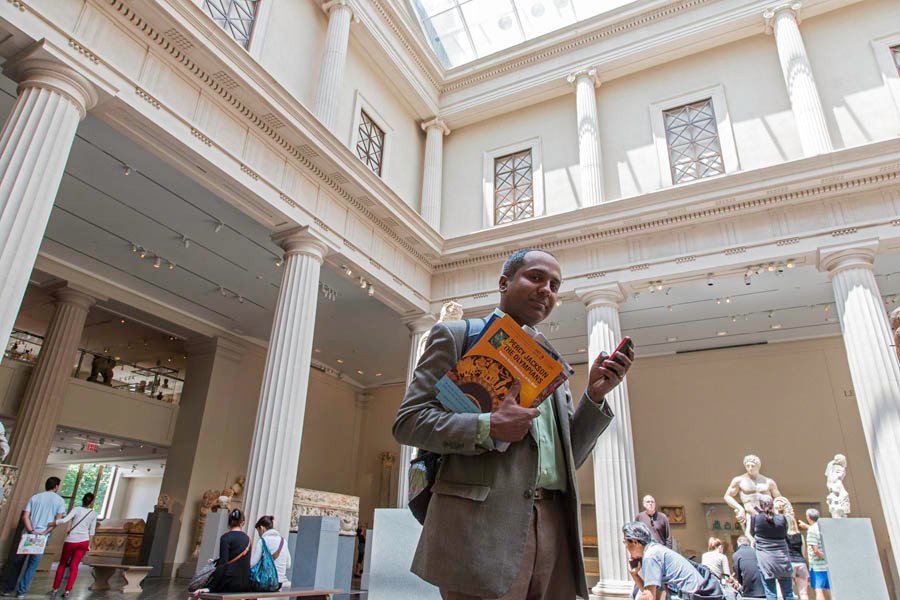
Sree Sreenivasan: America’s Tech Guru

When Sree Sreenivasan (@sree) was appointed Chief Digital Officer at the Metropolitan Museum of Art in 2013, that was the latest step in what he calls “a three-decade, one-way love affair with one of the world’s great museums.”
Since his appointment, a lot has happened at the Met, reflecting Sree’s expertise in all things digital, especially social media.
In April 2014, the Met’s Instagram account was selected as the Webby Award Winner in the Social Arts & Culture category in the 18th annual awards program. (The Webby, presented by the International Academy of Digital Arts and Sciences, is the leading international award honoring excellence on the Internet.)
In September 2014, the Met launched an app on iPhone and iPad that was used more than one million times in its first nine months. Of this feature, Sree (rarely is he called “Mr. Sreenivasan”) said that it “serves as a digital companion before, during and after a visit to the Met—and it’s accessible to our international audience, with whom we are always trying to connect better from afar.”
The goal of connecting with audiences everywhere is clearly being met. The museum’s digital audience is increasingly globally, with international users up to 36% on the website, 50% on Instagram, 54% on Twitter and 70% on Facebook. On Weibo, one of China’s largest social media networks, the Met had 10 million impressions in 2015.
At the close of the fiscal year, the Museum’s Facebook account had more than 1.3 million followers (with a reach of 48.5 million people) and its Twitter feed had 982,000 followers (with tweets receiving 148.5 million impressions). The website had a total of 32 million visits.
All this online activity has led to record-breaking visits to the brick-and-mortar museum. In July it was announced that a record 6.3 million people – from the United States and around the world – had visited the museum during the fiscal year. This was the highest visitorship since the Met began tracking admission statistics more than 40 years ago.
When these changes are mentioned to Sree, he acknowledges them happily – but declines any credit, preferring instead to mention “our team” (At the Met, he leads a world-class team of 70 working on topics he loves: digital, social, mobile, video, data, email apps and more.) “It all starts with Tom Campbell,” he says emphatically, “who embraced the idea of a digital Met.” (Thomas P. Campbell is the museum’s director and CEO.)
“We are building a virtual circle with people all around the world. When they come in person, we want them to stay connected to the museum Attendance has changed and grown and broken records. We are increasing access to scholarship, but there is no dumbing down anywhere. We work at a deep scholarly level and also a lighter one. We want to achieve a balance and to serve all ages.”
Expanding the commitment to serve all ages, in September of this year, the museum launched #MetKids, a new online feature with multimedia content made for, with and by kids.
“The full effect of what we are doing will not be seen for years,” Sree reflects, pondering the question of how to best make connections and how to make them have a serious result. To make the point, he adds: “Few of us saw how quickly Instagram would grow.”
Sree joined the Met after spending 20 years at Columbia University as a member of the faculty of the Columbia Journalism School and a year as the university’s first Chief Digital Officer. As an adjunct professor, he still occasionally teaches at Columbia, where he is fondly remembered by both students and associates.
Liz Borod Wright first met Sree when she was a student at Columbia’s Journalism School. Ten years later, she became the adjunct professor for his social media lectures for three years. Liz recalls those years: “Sree’s lectures are so entertaining that students don’t even realize the sheer volume they’re learning until long after it’s ended. His enthusiasm for social media is contagious; it’s impossible to hear him speak and not feel inspired to use social media for whatever your personal and professional goals happen to be.
“I’ve seen students attend his social media lectures multiple times, traveling for hundreds of miles just to hear him speak because they will always pick up something new. He is always up-to-date on the latest trends, technologies and data. But his real passion is for helping people. He loves to ask for people’s twitter handles so the group can follow them, and then he’ll give an individualized critique as to how the student can do better. Sree’s passion for helping and teaching is evident in everything he does, but especially in how his lectures would frequently run an hour over their ending time — and even then he’d continue the conversation with students over pizza.”
Given the depth and breadth of Sree’s involvement in the digital world, one would expect that his own 12-year-old twins would have started using social media while they were toddlers. Not so, he says. In fact, the opposite is true, as Sree and his wife, Roopa Unnikrishnan, resisted involving their children in social media. “People were surprised,” he says. “We were among the last to get the kids cell phones. You don’t need one when you’re a kid – and we saw that lots of technology people were restricting the use of technology with their kids. Now the twins are 12 and they are on Instagram.”
So are they aware now of how prominent their dad is?
“Well,” Sree replies, “they’ve been dragged to some events, so they are somewhat aware, but not the full range of what I do.”
The “full range” of what he does is impressive: In 2015, he was named to Fast Company’s list of 100 Most Creative People in Business, in part for the work he and the museum are doing on the future of culture.
In 2015, he joined CBS Radio’s new Play.It podcast network with the “@Sree Show: Talking tech, culture, entrepreneurship”
In 2009, he was named one of AdAge‘s 25 media people to follow on Twitter and in 2010 was named one of Poynter’s the 35 most influential people in social media; in 2014, he was named the most influential CDO in the US.
He is co-founder of SAJA, the South Asian Journalists Association, a group of more than 1,000 journalists of South Asian origin across the United States and Canada.
Though Sree’s involvements have been international in scope, he says he has “an immigrant mindset” that makes him more appreciative of his city and his country. Understandable given the fact that his father was a diplomat for the Indian government, a post that meant frequent relocations. So Sree was born in Tokyo, Japan and grew up in the USSR, Fiji and India. He attended kindergarten in Moscow, P.S. 6 in Manhattan, Marist Brothers High School in Suva, Fiji and St. Stephen’s College in Delhi, India. (He graduated from Columbia University with a Bachelor of Arts in history and received a Master of Science degree in Journalism from Columbia’s Graduate School of Journalism.)
Today, as a leader in all things digital, Sree retains his love for the printed page and believes that technology can’t completely replace the daily newspaper. He mentions that “in other parts of the world, print newspapers are still strong.” They are also strong in the Sreenivasan household; Sree subscribes to both magazines and newspapers. And as for books, he points out that E-book sales have fallen, but the numbers for print books has risen.
“Print is still relevant on many levels,” he says, “as a kind of backlash and also due to the fact that technology has not yet caught up. A digital image, for example, can’t compare with a beautiful coffee table book.”
Warming to this theme, he says: “An email ‘thank you’ cannot compare with a card. I keep every card I receive from students and friends – and I display them all.”
As if to further demonstrate the backlash against a tech-loving world, Sree says: “Vinyl records are selling again, and cassette tape sales had their best year since 1967. Can you imagine? I didn’t even know they were still around.”
Since Sree lives so much of his professional life in the spotlight, was there anything about him that hasn’t been widely discussed? “My first job,” he says. “It was handing out flyers at a pharmacy on 88th and Madison. So many people refused to take them, it got embarrassing. So I resolved that when I got older, I would always take a flyer from anyone who was handing them out. If you walk with me, you will see that I do that.” And if you walk with Sree, you will also see that he is always tweeting about the world around him, always finding something new and interesting to add to the conversation.
If you’d like to know more about Sree Sreenivasan:
You can find him on Twitter at http://twitter.com/sree and on Facebook at http://facebook.com/sreetips and on Instagram at http://instragram.com/sreenetand on the web at http://sree.net







































